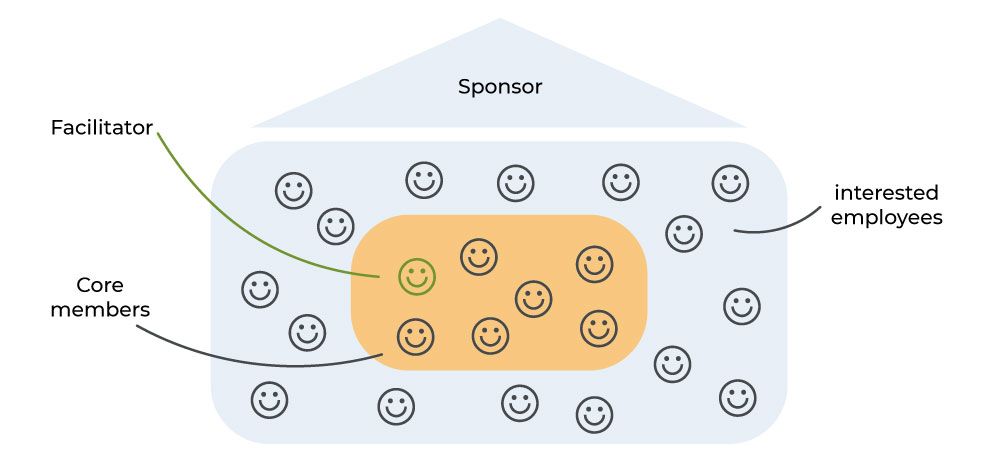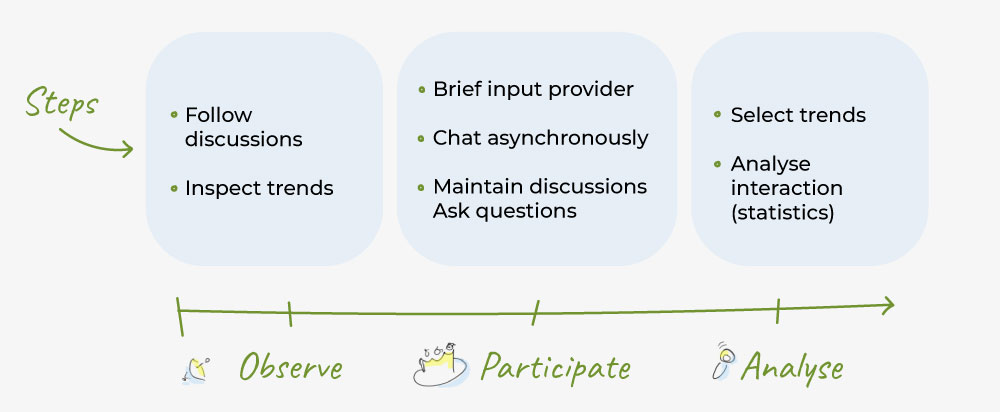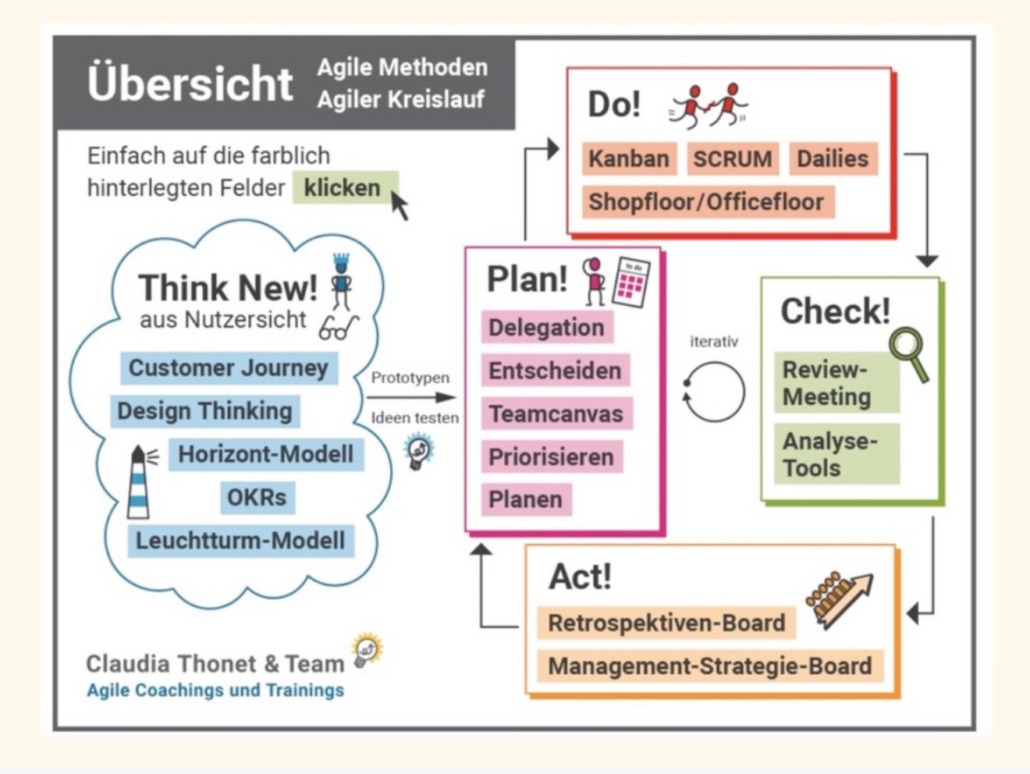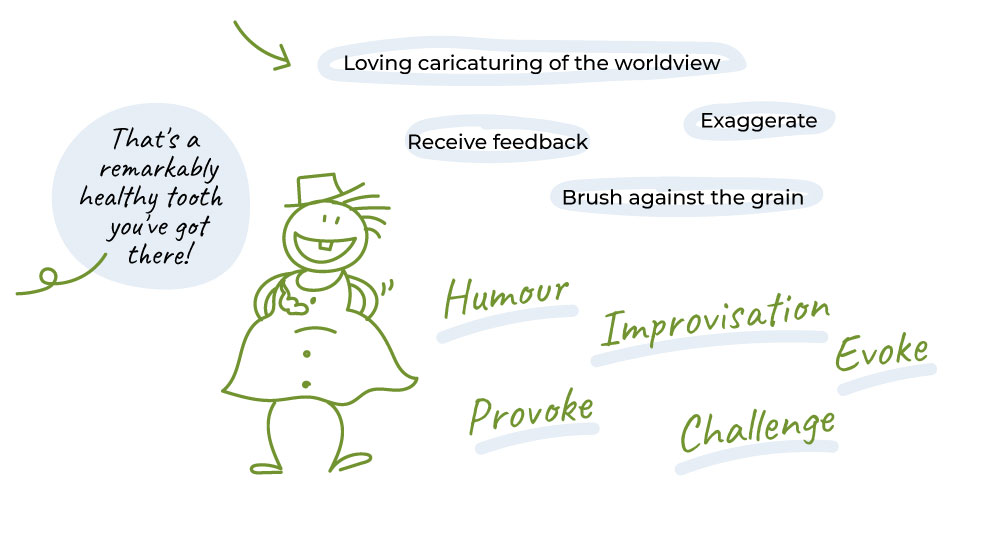Guidelines for a flourishing community management
Community management is crucial for a learning organisation. Particularly in teams and large companies, being well networked among each other, maintaining relationships between employees and establishing a smooth communication flow is pivotal. This ensures that the organisation remains flexible and adaptable and can respond appropriately to internal challenges as well as external stimuli, such as the COVID crisis.
Community management describes the architecture of a company’s virtual community and fosters the exchange of knowledge within the company, but also between other companies. But, this can only be a sustained success, if you bring all employees on board. The key is a learning organisation. Only when all participants work in unison, when they have the big picture as a common goal in mind and are open to change, can a team enjoy successes as a learning organisation. The team’s ongoing development as well as the increase of digital collaboration and the creation of the necessary agile structures are crucial.
Flourishing community management creates the basis for true collaboration.
In the following, I’ll share my wealth of knowledge and experience with you and spell out what matters. In addition, you’ll get tool tips that will help you take collaboration in your company to the next community management level and get your team to deliver.
What does community management even mean?
Community management regularly brings people with a common interest in a certain topic together through different means of exchange. The community meets on or offline to achieve a common goal (a vision). The dialogue is conducted in a favourable and unbiased manner, while the group actively shapes it.
Community management is the term for all methods and activities related to the conception, establishment, management, operation, support and optimisation of virtual communities. It requires different, previously defined roles or a community management team. I will go into this in more detail later.
The basics of community management
A well-organised community management provides agile working methods for your team to work together on point. In order to give you a good overview, let’s start with the basics.
What you need to know about community management?
Depending on what you want to achieve as a company, or what goals are added after you embark on new territory, you can build and expand on your already existing experience and knowledge. You don’t have to know everything from the start. In fact, what really counts is a feeling for the community’s needs and the willingness to deal with them constructively as well as to grow with them.
What is crucial?
A general attitude and openness within the company is a key factor of a flourishing community management. Above all, this includes the following:
- Self-responsibility:
„I assume responsibility, I want to be involved.” - Voluntariness:
„Nobody forces me, I do it of my own free will.” - Netiquette:
„What are the dos and don’ts?” → discuss in the community
In addition, the following things should be clarified within the community:
- Roles
- Workflow
- Methods
- Case studies & good practices
I’ll enlarge upon all points in the following and provide a deeper insight into the topic.
What are the roles and associated tasks?
It takes more than a leader and the associated community for a community management to flourish. For a community to do so, it’s essential that roles and tasks are clearly allocated so that the network can be used in the best possible way.
So let’s take a look at the different roles and their associated tasks in more detail:
Community Sponsor: An influential person in the organisation who fully supports the subject-matter and goals of the community. Management sponsors are vital for the legitimation of the community and the availability of resources.
Managers of community members: Since membership in a community is usually not an official role and not included in the target agreement, the managers of the community members can act as their “sponsor”.
Community Manager: This person is responsible for coordinating the planning, launch, activation, management and transformation of the community. The role of community manager can either be assigned to one person or be distributed among several people (recommendation: at least two, in case of distributed communities additional local community managers, if necessary).
Community managers should not see themselves as the “boss” of the community, but rather as the “host”. In practice, there are several common names for the role of community manager out there (e.g. community coordinator, community leader, community facilitator, expert forum speaker). I also understand community managers as “hosts”, facilitators, gardeners, pilots.
Community members are employees who participate in the interactions of the community. In doing so, they are beneficiaries and/or generate benefits for others.
Members of a community can be categorised according to their level of activity (e.g. core members, active members, peripheral members/lurkers). Community managers should not expect 100% of the members of a community to be active members.
Community Management Team (optional): Depending on the size and importance of a community, it may make sense to distribute the tasks of a community manager across several shoulders. This is particularly useful for communities on specialist topics where the community manager is not the subject-matter expert.
Subject-matter experts can be included in the community management team.
Furthermore, it is advisable to enlarge the community management team in global communities through local representatives in order to be able to take local needs and specifics into account.

Every community depends on the participation of its users. It’s therefore advisable to identify so-called “friendly users” in addition to the roles already described and to promote and value their participation accordingly, e.g. by means of badges (see below). This brings us to the three key steps in the cyclical development of a community.
3 steps to cyclical community building
A community builds itself iteratively, collaboratively, in several steps and ideally cyclically (see methods). The 3 basic steps are:
- Observe,
- Participate and
- Analyse (see sketchnote).

One way to a sensible workflow from my experience is the TPCDA cycle by Claudia Thonet.
Methods and tools
Digital methods and tools are useful aids for building an interactive community. We can benefit from certain methods on a large scale, for example from the agile setting or project management. But also on a small scale, when it comes to planning a community session and designing it interactively.
Methods to design a process (on a large scale)
- The TPCDA cycle is a good way to create the workflow together. Helpful questions you can always ask yourself are: Where do we want to go? And how do we get there? The TPBCDA method works both on a large scale, for all activities, and for the individual sessions that take place in the community. The classic PDCA cycle from project management is expanded in the agile environment by the recurring innovation, the “think new”, from the customer’s perspective. Rethinking and innovating has simply become crucial in the disruptive market. In addition to the ongoing business, innovating the existing as well as exploring new business areas and markets is decisive for the sustainability of the company. Therefore, start the agile cycle with your vision and future offerings from the customer’s perspective. You can find an interactive explanation of the individual phases of the cycle here: https://www.claudiathonet.de
- Another useful format can be the activity plan. Source: https://www.communitymanagement.de
- For experienced participants who have already gone through several cycles, it may be useful to precisely analyse or track the community’s engagement with appropriate tools (such as https://www.conversar.io).
Additional tools and methods in the process (on a small scale)
- Ask questions
This may sound simple, but asking questions can be very effective to spark participation. Asking good questions can build relationships and trust – something we want to foster in the community. But what constitutes a good question? Source: https://www.claudiathonet.de/agile-methoden/
Source: https://www.claudiathonet.de/agile-methoden/
- We all know this question: “How are you? It’s a trivial, everyday question that we expect to come. It doesn’t challenge us, and we regard it as an empty phrase. And that’s exactly how we treat it. We usually answer in the same way, in a way that is expected, ordinary and banal. But what would it be like if we were asked this question instead: “What was the most beautiful thing you experienced today?” This question triggers something in us: To answer, we’re suddenly forced to review our day. What’s more, we really have to think about what the most beautiful thing actually was.
- Unlike the first question, we don’t usually know the answer beforehand. It’s so much more than a question; it’s an invitation to engage with ourselves and in a real conversation. A check-in question like this is therefore a best practice for community management. I’ll get back to this later.
- Visualisation welcome
Visual content appeals to us on an emotional level. It helps us process information much faster, and to recall it. Complex things can be better illustrated. This is the reason why I like to accompany community sessions with sketchnotes and or design thinking. 
- Using interactive online tools and apps
Probably the best-known collaboration platform is MS Teams, a platform developed by Microsoft that combines chat, meetings, notes and attachments. Apart from the classic features like breakout rooms, you can also make use of surveys and work with a whiteboard.
If you’re not bound to the MS Teams platform, you can also use external tools and apps that enable virtual interaction and visualisation:
– Miro (whiteboard alternative)
– Collaboard (whiteboard)
– Google Jamboard (whiteboard alternative)
– Streamyard (livestream software alternative)
– Zoom (livestream software alternative)
– Slack (messenger for team communication)
– Yammer (a Microsoft tool) There are also apps that invite the community to take part in a little “virtual trip”. For this I like to use: Wonder.me, HyHive.com or Tricat-spaces.net
Not quite sure? → “Please check with your personal IT”
Communities take place almost exclusively on the screen. That’s why it’s so important to me to incorporate exercises that address the entire body. For this, I suggest small “embodiment exercises” to relax and interact. Adopting a certain body posture or changing facial expressions and gestures, as we do for example when we’re laughing, can also evoke a corresponding psychological reaction and vice versa. In fact, laughter is always one of the best ways to achieve lightness, joy and participation. When I have fun doing something, it also catches on the community. You can find more inspiration from my respected colleague Wiebke Wimmer.
“You can’t take lightness and humour too seriously!” Michael Bohne

- Community actions
It is possible to increase participation through simple actions. Popular and proven speed formats can be:
– Quote of the day
– Crossword puzzle
– Check-in scale from 1-10 “How are you feeling today?”
– Badges: give community managers the opportunity to recognise and reward members for their contributions
Good practices in community management
In the following, I’d like to share an example of a successful community meeting on a small scale with you.
Step 1: Open room
Here you can start directly with one of the speed formats mentioned above, such as the quote of the day, or a check-in question.
The aim is to get the group of fans/friendly user (know the fans of the topic aka community! – Start with small group) into dialogue.
Step 2: Fill room
Now it’s essential to fill the created space with the corresponding topic AND with life. The community may and should become active!
- Know your community → you can better respond to their needs/wishes
- Use the various possibilities that are available to you. These can be, inter alia, breakout rooms, video recordings, or the whiteboard
- Control and distribute the attention of your community
- Reply to posts, sometimes quickly and sometimes slowly
- Be responsive to criticism from your community and show them that you care about them and their concerns
- Offer added value incl. trustworthy evaluation, e.g. offer your own expertise as a contribution to certain questions
- Determine what is useful to fans? Likeable content e.g. quote of the day; invite fans
Step 3: Close room
Once again, you can use methods to round off the community meeting and end it together. Here’s a little inspiration:
- Quizzes
- FEEDback&forward
- Present an outlook via Backlog
- Post articles
- Say thank you when your own content is shared #appreciation → communication order
Dealing with difficult situations
Good moderation and facilitation prevents heated discussions. However, should a difficult situation arise in the community, first take a deep breath and remain calm. Then take a close look at what happened and analyse what could have caused the discussion to go in that direction. Only then react to the comments. Nonviolent communication (NVC) is a helpful approach.
An introduction can be found here.
Case studies for flourishing community management
- Wiener Linien Digital Community
- Further examples via LernOS
https://www.muuuh.de
https://cogneon.github.io
Inspiration
I’ve already explained that it’s an important step for community managers to monitor trends and encourage innovative thinking. Meet-ups, webinars, podcasts and social media are wonderful sources of valuable inspiration. Helpful resources can be found here:
https://www.zukunftsinstitut.de
Conclusion
Community management is a task that should not be underestimated. Giving it enough space and focus offers huge potential to promote the exchange of knowledge in companies. To me, the advantages are unbeatable!
Here’s an overview of my 5 most important points:
- Build on good practices on community management
- Define roles and associated tasks
- Use varied agile methodologies and tools, e.g. visualisation on the whiteboard (see above)
- Activate impulse contributors and build up a backlog
- Enable asynchronous communication via e.g. MS Teams, Slack or the like. More recommendations can be found here: MS Whiteboard







